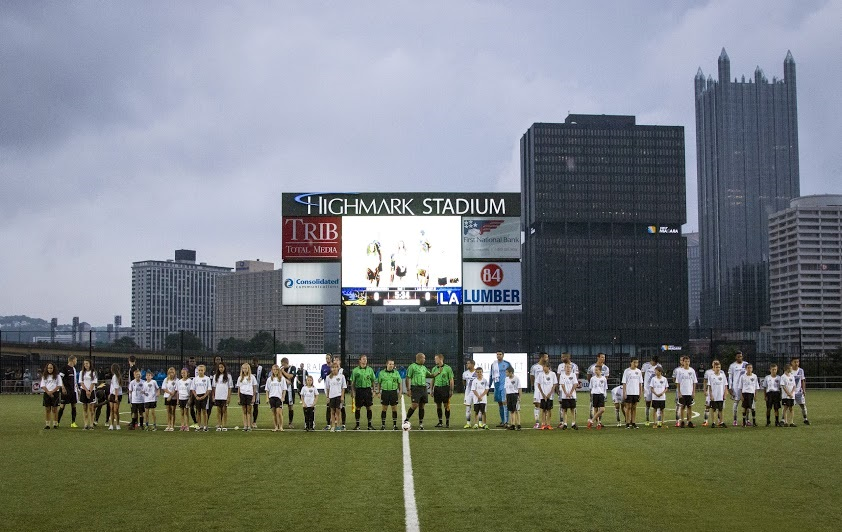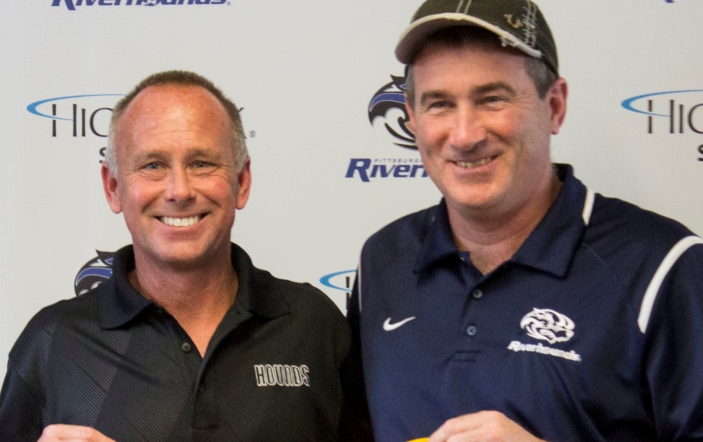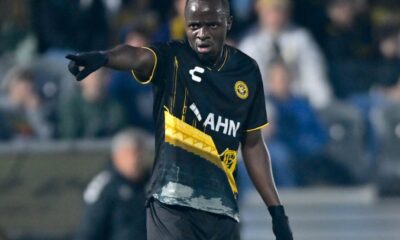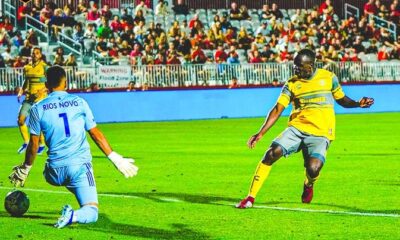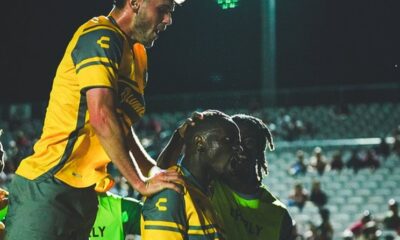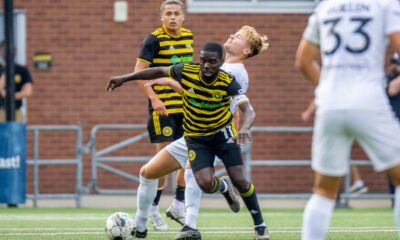
As the off season begins for the Pittsburgh Riverhounds after a lousy 2016 campaign (final record 6-17-7, finishing 2nd to last out of 14 USL Eastern Conference teams), my colleague at the Pittsburgh Tribune-Review, Matt Grubba spoke with team owner Tuffy Shallenberger earlier this week to clear the air on a few topics.
If you thought it would a quiet off season for the Riverhounds, you might want to think twice.
And forgive me as I may be asking a lot of questions for the remainder of this article — as there remains a lot of uncertainty of what lies ahead for Pittsburgh’s pro soccer franchise.
Maybe, just maybe, the final quote from Shallenberger in Grubba’s article may be the most telling.
“There’s going to be a lot of things changing here, but this club isn’t going anywhere,” said Shallenberger.
“It’s here to stay.”
I explored this topic (and all things Riverhounds) with the Mon Goals podcast crew in the Riverhounds 2016 Season Review show earlier this week.
The bottom line from my perspective among a few of my takes during the show was that pro soccer in Pittsburgh can — and should be doing much better than the current state of affairs.
Shallenberger says that he wants to implement changes.
Now comes the hard part. Making it happen and building a successful outfit.
As the franchise will embark on its 17th season in 2017, here are some questions that are fair to ask:
- Can Shallenberger bring on a general manager/team president to steer the pro club in the right direction and keep up in a time of great competition and transition as the landscape of professional soccer in the U.S. continues to evolve?
- Will the Hounds seek additional investors and potentially expand the ownership group (or find additional revenue streams) and business operations — and get more buzz to support the team and fill Highmark Stadium regularly ?
- What is the strategic plan for this organization?
FINANCIAL STATUS
According to Shallenberger in the Pittsburgh Tribune-Review article, nearly two years after he absorbed majority ownership of a franchise that emerged from a Chapter 11 bankruptcy filing, the debt incurred to the pro team has been cut in half.
Shallenberger feels that they are now in a competitive position financially.
“Financially, we’re fine. We have a lot of good things coming with sponsors, but we definitely took a hit at the gate and we took that hit because we’re not winning,” Shallenberger told the Tribune-Review.
“You’ve got to win in Pittsburgh.”
He also feels that the Riverhounds payroll is comparable to the competition.
“That’s not going to be a problem. Player payrolls aren’t real extreme. If you go from the top team to the bottom team (in USL), it’s not real far off,” Shallenberger said.
Then of course, there are operational costs along with community outreach, promotions and marketing.
To run a pro soccer team, it’s imperative that there’s a clear-cut plan in terms of making personnel decisions and having players who will be a good fit for the team.
If Shallenberger and the Hounds are comfortable with where they are with payroll, now they have to carefully craft a team within the parameters of the resources they have that can have good chemistry.
In 2015, it seemed as if they did a nice job of doing this, with a USL Hall of Fame Coach, despite a limited payroll and many new players.
Shallenberger intends to reorganize — and among the additions he said will finally be someone in the role to guide and work with the coaching staff on personnel decisions.
In our podcast the other night, one common denominator among the panelists was that this franchise is facing an identity crisis.
Having some front office leadership will help provide a clear direction with regards to the pro soccer team.
In addition, there’s been some push from fans and soccer followers in Pittsburgh to see the Riverhounds re-brand.
That would provide a fresh new look and identity.
The consensus among many is to develop a soccer crest, and a name change away from the “Riverhounds.” Alternatives could include something that identifies the team as a soccer/football club (FC Pittsburgh or something along those lines) — and take the focus away from the cartoon-like Hound logo design.
In a market that boasts itself as a “City of Champions,” the pro soccer team could serve itself well by aligning and embracing the other sports teams and traditions already built in Pittsburgh. This has been something that FC Cincinnati has done very well and the Riverhounds should position themselves stronger with the people, places and traditions of one of America’s great cities.
These changes will require a lot of hard work, additional financial resources and ownership that is willing to spend to broaden is base of support and extend its reach into the community. It will also require that there’s an extensive marketing campaign that helps create greater awareness (more on that in a bit).
As I mentioned on the Mon Goals podcast, the team had put forth a re-branding plan last off season, but apparently they could not finalize and have it ready for the 2016 season and the plans to complete the re-brand were scrapped.
While the re-branding would be nice, the organization still needs to figure out a number of other things first.
DOES HOUNDS ACADEMY GET IN THE WAY?
While the Pittsburgh-area has been lacking when producing top-tier professional men’s soccer prospects, the organization is committed to a separate entity from the pro team — the Riverhounds Development Academy (RDA).
The RDA have a full assembly of paid staff within its structure which includes a full complement of youth academy teams along with instructional clinics.
Shallenberger has boasted that the Academy has been profitable — and while just in its infancy (Academy teams just started playing together in 2009, with the first class of high school seniors now playing at the college level this fall).
This is not an academy that is currently bringing through many players that have developed into homegrown players for the Riverhounds and/or are moving on to higher levels. It’s still primarily in its infancy stages.
Meanwhile, the Riverhounds’ pro team has been operating without a full complement of staff — and primarily without a true general manager or personnel director. The team’s front office was spearheaded by Richard Nightingale during the 2015 season. Nightingale was very involved in personnel decisions, but also had oversight of operational side of the pro team so with limited staff, he was doing a little bit of everything. Prior to the 2016 season, Nightingale was no longer with the team, and Shallenberger, a successful business owner who capitalized on Marcellus Shale boom with this company Shallenberger Construction, assumed the “interim” team president duties.
While a few RDA staff and some of the pro players may straddle along and be working for both entities, there remains some crossover. This current situation has some players also coaching and conducting training sessions for the Academy. It also has a few staff members who are completing tasks and roles for both the pro team on game days and with the academy as well.
This may be something that may have to be given a long, hard look — and brings a legitimate question that should be explored…
Is the RDA getting in the way of the success of the pro team?
Or can both entities co-exist under the same roof?
Maybe its time that the two sides go their separate ways.
Many other USL teams have academy programs, but in almost each case, they are entirely separate and keep affiliation mostly in name and in minimal partnerships.
If the Riverhounds pro team is going to grow and increase fan support, they might be better utilized doing various outreach clinics, community service activities/volunteering and promotional appearances rather than coaching academy teams.
It’s not the die-hard soccer fans that the Hounds need to attract to Highmark Stadium, it’s new fans and the general public.
Hopefully with some more resources, they can increase community service and outreach efforts in the coming year.
Also, I found it interesting that earlier this year, the Pittsburgh Business Times reported that Shallenberger (on behalf of a non-profit entity “Friends of Pittsburgh Soccer” was in negotiations to develop a new soccer training facility in partnership with Allegheny County.

Here’s a map of potential soccer training complex that spans Moon, Coroapolis and Robinson Twp. at Montour Junction. (Map courtesey
This is a sign that there are considerable efforts being made to ensure more growth of the RDA — as the Hounds want to ensure that the Academy teams and programs have quality playing fields and continue to find ways to generate revenues.
While this project may or may not happen anytime soon, it could be a nice addition for the RDA.
So, what does this have to do with the pro team?
For one thing, it could be a sign that the Academy could completely transition to a new facility — paving the way for a more complete split between the two.
This is probably something that will take some time, but in the bigger picture, it might be what would be best for both the pro team and for the academy to go separate ways while maintaining an alliance much like most other USL and MLS teams have with their academy programs.
ATTENDANCE, COMMUNITY SUPPORT DECLINES
The Hounds have dedicated staff that devote a lot of responsibilities to the operational side of the pro team and work with a shoe-string budget — from sponsorship and community partnerships, ticket sales and media relations.
Most of the team’s promotions in the past few seasons have been done with limited resources and give-away nights for the fans included opening night scarf, hats and t-shirts for two additional games.
Halftime entertainment have included Pogo-Stick jumpers, Primanti Brothers sandwich eating contests, relay races, dancing, and basically whoever is willing to pay or broker a partnership to be on the halftime stage.
In the past two years, as the Riverhounds have escaped the cloud of bankruptcy, the organization’s presence in a mostly traditional demographic market has been non-existent with only a few promotional appearances here and there and no media buys.
The Riverhounds have one valuable resource that many teams in USL or NASL in second or third division soccer would cherish — Highmark Stadium.
Not too many other teams have a facility that is soccer-only, and located with a spectacular view of its metropolitan Downtown skyline in the backdrop. When the stadium made its debut in 2013, it was hailed as a new U.S. soccer gem.
But, despite this, attendance that has steadily declined since that promising season.
Empty seats for many games remain the white elephant in the facility that was supposed to deliver so many new fans to Pittsburgh’s only pro soccer team.
So much for — “If you build it, they will come.”
When Shallenberger addressed the issue of lagging attendance in the Trib article he cited having a losing team as the main reason. (attendance in 2016 was the worst in the Hounds four seasons in Highmark Stadium as the Riverhounds barely broke a 2,000 fans per game average). Ironically, the season finale against FC Cincinnati in mid-September, with nothing at stake for either club and a losing season clinched months prior, the Hounds drew its highest attendance number, over 3,100.
Even in what was a remarkable 2015 season where the Hounds had one of the highest scoring teams in USL and played to a packed, standing room-only atmosphere against D.C. United, overall attendance didn’t improve.
Looking around at the rest of the USL, the Hounds attendance is somewhere on the bottom side of a league that features a handful of MLS “B” teams.
If you look westward up the Ohio River at first-year Cincinnati and second-year Louisville — there are franchises having significant success at the gate with little or no previous pro soccer history. Cincinnati has blown everyone out the water this year with a phenomenal average over 20,000 plus per game.
Cincinnati’s ownership group has pumped a lot of money into advertising and promotions in the community, brought in former U.S. National team/EPL/MLS player John Harkes to coach the team, and have been shattering league attendance records along the way.
The Riverhounds have been around since 1999.
Twice in its history they’ve had a surges in attendance — but both times — the numbers of fannies in the seats eventually steadily declined after the initial surge.
Of course, I am talking about the franchise’s inaugural season in 1999 (over 4,000 fans per game at Bethel Park High School) and of course, the season they moved into Highmark Stadium in 2013, started with much promise and close to regular sellout attendance in the 3,500-seat stadium.
Ask yourself, when was the last time you saw a Pittsburgh Riverhounds advertisement — in print, on a billboard, on the radio or television?
Ask another question — have the Riverhounds ever had games air on local television or local radio stations?
(they actually did get on Channel 22 – The Point for one game in 2015, but that was it).
Much more needs to be done to get the general public on board.
Shallenberger said the Hounds are not going anywhere.
Ok, with that being the case, they need to make more of an investment to get more people to come to Highmark Stadium.
TEAM BUILDING
Shallenberger told the Tribune-Review that he believes in his new coach, Dave Brandt, who finished the season with a 5-11-5 record after taking over for Steffens in May.
“It’s easy to question because we aren’t winning. I’ve been quiet lately, and (the team) has taken their lumps on Twitter, social media,” Shallenberger said.
“But I know what’s going on behind closed doors. A lot of changes are being made, and I couldn’t be happier with (coach) Dave (Brandt) and Dave will be here a long time.”
On the field, the roster will change every season.
That’s the nature of pro soccer at this level.
Dave Brandt (left) and Tuffy Shallenberger in May
It would be nice to see the right core group of players that they can build around.
They’ve tried this in the past (remember after a successful 2013, the “resigning” of Jose Angulo and Matt Dallman, and even after the positive 2015 campaign Kevin Kerr, Lebo Moloto, Willie Hunt, Mike Green and others came back to the roster).
Coming back in 2017, the Hounds have Kerr for his fifth season in Pittsburgh, and promising newcomer Chevaughn Walsh signed to contracts, and they have an option on the team’s leading scorer, Corey Hertzog.
Other than that, it looks like they are going to have to build the roster from the ground up again.
And it appears that Brandt is going to get some help.
Shallenberger also told the Pittsburgh Tribune-Review that he will bring someone in to work with Brandt on team personnel.
What the Hounds need is a team structure, coaching and front office that are all on the same page to provide players that come (and go) with the structure and environment that has clearly laid out expectations and prepares them to be successful.
Case in point — the Rochester Rhinos.
The Rhinos roster may change each March and April, but having a strong coach like Bob Lilley has ensured that the team has a specific system of play, has the same type of players and they stick to a philosophy that mostly works. Even through some turmoil that forced an ownership change and much needed stadium upgrade, the Rhinos are perennially one of the top USL teams – winning the league in 2015, after surrendering only 15 goals.
The question will be, can Brandt, who’s never coached or been involved with making personnel decisions at the pro level before this May, develop a successful system and build a successful team at the pro level year-in and year-out?
In 2016, there was a lot of turnover — even for a third-division pro soccer team.
- Of the original 22 players on the roster, eight (James Bissue, Conor Branson, Caleb Postlewait, Isaiah Schafer, Karsten Smith, Ryan Dodson, Romeo Parkes and Mauricio Vargas) were released or had their contracts terminated.
- In addition, unsatisfied with the team’s slow start, Shallenberger fired the coaching staff (USL Hall of Fame Coach Mark Steffens and assistant coach Josh Rife), and brought in a new coach, Mark Brandt (who hired a new assistant, Gary Visser).
- Another eight players (Alejendro Aguilar, Ryan Adeleye, Danny Earls, Jack Thompson, Nick Thompson, Melvin Snoh, Anthony Virgara and Chevaughn Walsh) were added to the team after the season started. The doesn’t include a few more players on loan from the Columbus Crew including Zach Steffen and Cristian Martinez, who played a lot in the games down the stretch.
Much of the roster turnover this year could be attributed to the coaching change. There were also two significant suspensions — including the now infamous Parkes’ kicking of NY Red Bulls II Karl Oiumette incident, which caused the Hounds to terminate the Jamaican forward’s contract. That incident alone was likely the major domino that began to see the season completely unravel for the Riverhounds.
Veteran Irish midfielder Earls also was given a seven-game suspension for an August incident in Harrisburg in which he drew a red card for an altercation with City Islanders players after a dangerous tackle, then pushed the official.
Brandt steered the team to the finish line — and after the last game felt like he was ready to take a step back, but still get to work right away.
“We do need an off season. A chance to regroup. And that starts right away,” said Brandt.
“Actually, it starts now.”
The team’s best player in 2016 was arguably center back, Jamaican Sergio Campbell.
A former first-round MLS superdraft pick of the Columbus Crew, Campbell sat out most of the 2015 season, and found a chance to play full time with the Hounds in 2016.
It might be in the Hounds best interests to re-sign Hunt, who was voted the Steel Army player of the year, and Campbell to solidify the team’s back line. That being said, I wouldn’t be surprised Campbell might generate a lot of interest from MLS or other clubs elsewhere.
COLUMBUS CREW PARTNERSHIP
During the 2016 season, the Riverhounds struck an affiliation agreement with Major League Soccer’s closest geographical team, Columbus Crew.
Despite the unsuccessful season overall in USL play, it seemed as if this partnership from worked out pretty well for both sides in 2016.
Unlike in 2014, when the Hounds partnered with Houston Dynamo, and had some inconsistencies with when players would be available, this year provided more consistent contributions from the players on loan, most notably Marshall Hollingsworth who played the entire season with Pittsburgh, and later in the season Zach Steffen and Cristian Martinez were both valuable contributors.
The Hounds should look to continue to partner with Columbus as affiliate if for any other reason to be able to add quality players to the roster, who they don’t have to pay salary. If they are guaranteed to have a few players like Hollingsworth for a whole season, then it’s works out for both sides.
Another carrot dangling in this partnership is the potential for the Riverhounds, who have no general manager at the moment, and even if they hire someone — still a limited front office staff – could turn to the Crew to be more involved as an affiliate partner.
There’s only one other USL team, Rio Grande Valley FC Toros, the current affiliate of the Dynamo, who share such an agreement that has the MLS team overseeing all soccer related — personnel and coaching decisions, while the franchise handles the operational side of the equation.
Working closely with the Crew, regardless of how it’s set-up, would likely benefit the Hounds.
This could provide Brandt and personnel director with a lot of support and direction in building the team.
The caveat in all of this is that Columbus would always view Pittsburgh as developmental side, and the Riverhounds, if serious about winning and providing Pittsburgh fans with a championship caliber team, would have to wrestle with that challenge.
Brandt, a high energy coach who is very active on the sidelines, also believes strongly in structure, teaching details, and building strong habits of young men — much to Shallenberger’s pleasure — and maybe even the Columbus Crew too.
US PRO SOCCER’S LANDSCAPE CONTINUES TO CHANGE
Major League Soccer is adding new franchises in Atlanta, Los Angeles and Minnesota.
The USL, considered the third division of U.S. Soccer, will be adding more franchises in 2017.
While the NASL, considered the second division, will also add a new team in Northern California, but despite issuing statements showing solidarity among its core teams, has seen some recent developments that could see up to five teams leave the league.
Regardless of what transpires in the short term, the NASL may not be around in the long term.
This leaves the USL in position, and growing with abandonment, to take on the mantle of carrying the second division (and possibly the third division depending on how things shake out).
All of this of course is still mostly speculation. We’ll find out a lot more toward the end of this year.
If the Riverhounds want to put themselves in better position, now is the time to step up and make changes that are necessary.
Right now, if USL were to move upward, contrary to what Shallenberger said, the Riverhounds could likely stay in the third division status while some of the other USL markets like Cincinnati, Sacramento, Louisville and even some from the old guard like Charleston, Richmond and aforementioned Rochester would move into second division status.
There are a few independent franchises in USL facing operational challenges like Pittsburgh (Charlotte, while successful on the field, had poorer attendance numbers than the Hounds), but with many new teams coming in, the competition and the bar will continue to be raised for everyone.
What might help Pittsburgh, is if there’s a television contract developed for the USL and if the league can develop some revenue sharing possibilities. Still, that seems like a stretch to see that these revenue streams would be significant at all in the early stages.
Shallenberger believes that the Hounds belong in the second division.
They are going to have to go out and show that they belong in that conversation.
#####
You can follow Pittsburgh Soccer Report’s John Krysinsky on Twitter @pghsoccerscribe

